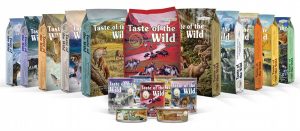re-post from author Krista Garver - Industry Perspectives.
Have you ever rummaged in the pantry for something to eat and come out with a can of delicious-looking chicken and vegetable stew that turned out to be dog food? I have. And it looked so good that I briefly considered eating it anyway.
The truth is, I probably could have. Thanks to changing consumer demographics and perceptions, the premium pet food market has been growing by leaps and bounds. This includes more pet foods being made with human-grade ingredients in facilities certified for the production of human food.
To learn more about the current state of the pet food industry and about how suppliers can help manufacturers meet consumer demands, we spoke with Aaron Merrell and Nichole Nonini of Plato Pet Treats. Merrell is the company’s CEO as well as a co-founder. He gave a presentation at PROCESS EXPO 2017 on how the pet food industry continues to evolve (watch the presentation on YouTube). Nonini is the marketing director. Together, their stories illustrate the new paradigm in which pet food manufacturers must operate to be successful.

Merrell has spent his entire career in pet food. His first job was at a company that processed and supplied meat ingredients to the pet food industry, where his dad was the operations manager. There, Merrell learned the trade from the ground up, starting out washing bins and stacking cardboard. He went on to work as a line operator, a forklift driver, and a lab technician. Through these jobs, Merrell not only learned the industry, but was able to pay his way through school.
The owners of the company had also been involved in another pet treat company, which they had previously sold. About the time Merrell was finishing his MBA, their non-compete agreement was expiring and they wanted to get back into the business.
Merrell was eager to get involved. For one of his classes, he wrote a business proposal that sought to capitalize on their collective strengths to carve out new opportunities. His proposal got a good grade, so he pitched it in what he describes as a Shark Tank moment. “I had some ideas and I stuck my nose in,” Merrell says. “They bit off on my proposal, and over the next year we pieced together the business.”
That was in 2005, and the company officially launched in 2006, specializing in responsibly-sourced high-quality pet treats. In 2012, they relocated from Indiana to Fresno, CA, so they could be closer to both their suppliers and a large portion of their customer base. Since then, Plato Pet Treats has seen year-over-year growth in the range of 40-50%, outpacing an already fast-growing industry.
Nonini, an experienced marketer, joined the team about three years ago. At the time, Plato Pet Treats wasn’t big enough to require a full marketing department. But she loved the company, the ideas, and the culture so much that she was wanted to be a part of it.
“I’m a dog person and a dog owner,” Nonini says. “I’ve always cared about my pets. When I saw the care, quality, and time that people put into formulating these treats — even rejecting ingredients that didn’t meet quality standards, which meant inventory would be lower — I knew I had to be a part of the team.”
Initially, she took a position that had nothing to do with marketing. A year later, Plato Pet Treats brought their marketing in-house, with Nonini at the helm.
Fur babies, pet parents, and the humanization of pet food
The single biggest trend in pet food today is what’s known as “humanization.” The term captures the idea that people are looking for the same things in food for their pets as they are in food for themselves.
“Pet food trends are closely following human food trends,” Merrell says. “Pet owners consider themselves parents, with pets as their ‘fur babies.’” This metaphor isn’t an exaggeration. According to Nielsen, 95% of American pet owners think of their pet as a family member. Not only that, but if money were tight, 55% would be willing to give up chocolate to ensure their pet had high-quality food, and 43% would be willing to give up their Netflix subscription.
This shift is driven in large part by Millennials, the demographic responsible for the free-from, organic, natural trends in human food. “People are reading every ingredient on the package and consulting with veterinarians. They’re going the extra mile to ensure the food they feed their pets has the functionality and positive health effects they’re looking for.”
This has led to a rise in popularity of attributes like grain-free, high meat inclusion, low sodium, and responsible sourcing. Merrell has even had people ask for vegan dog treats!
Trust and transparency
A complementary trend, which also mirrors the human food industry, is the desire for transparency. People want to know exactly what’s in pet food and where the ingredients come from.
As an example of a manufacturer that’s doing a great job in this arena, Merrell points to Spot Farms. They make products using proteins like chicken and turkey. The front of their packaging identifies the state where protein came from. On the back, you’ll find a map of the state and county, along with a picture of the farmer who raised the animals. That’s much more than most of us know about the chicken and turkey we buy in the store.
Merrell traces the transparency trend back to a scandal in 2007, when wheat gluten laced with melamine was found in pet foods. Although there’s no national database of pet deaths, the adulterated food is estimated to have sickened or killed thousands of cats and dogs. That incident, combined with recalls around the same time due to Salmonella and other forms of contamination, served as a wake-up call for pet parents.
“Nothing makes you feel better than giving something good to your dog,” Merrell says. “And nothing breaks your heart more than knowing that you unknowingly gave your dog something that hurt them.”
As a result, people started paying more attention. “We had a rosy outlook on our culture for a long time,” he says. “We trusted what was on the label. Now, that trust is broken. People are more cynical, and they want more transparency so they can ensure that you’re doing what you say you’re doing.”
New technologies driving innovation
Finally, the changes aren’t all in the quality of the ingredients. Merrell notes that cutting-edge technology is also making its way from human food processing to pet food processing.
For example, Stella and Chewy’s makes a raw product using high pressure processing (HPP). Freeze-dried foods are also starting to resonate with the market, as is low-temperature dehydration, a process that Plato Pet Treats has been using since Day 1.
“We built our product line around the low-temperature dehydration process,” Merrell says. “It’s more challenging than traditional baking processes, but it allows us to occupy that sweet spot between raw (which is palatable and nutritious) and cooked (which is sterile).” The process allows Plato Pet Treats to preserve the palatability and nutrition benefits while also producing foods that are safe.
What pet food manufacturers need from their suppliers

This new paradigm — where pet food is considered equivalent to human food, in both quality and processes — offers new opportunities. But it also requires suppliers to adopt a new perspective. This is where the challenge lies.
“Our whole industry was created as the result of the food processing industry finding solutions and adapting technology to upgrade the value of their materials,” Merrell says. “The more opportunities food processors can recognize and bring to the pet food industry, the more we’ll be able to innovate.”
There are two big problems currently standing in the way.
First, Merrell notes that many suppliers are still following the old paradigm, where pet food was a byproduct industry. “The consumer is starting to see pet food on the same level as baby food,” Merrell says. “But food industry suppliers and OEMs still consider it a byproduct industry. We’re looking for higher-value, fresher ingredients, while the older stalwarts are still looking at it almost as a waste stream.”
He recommends that food processing suppliers look at what human food companies are putting out and find ways to preserve, or even upgrade, that value for the pet food industry. “That’s what we’re looking for — a greater supply of high-quality products, not just the old commodity of meals and low-quality products that consumers don’t want anymore. The pet food industry is an extension of the human food industry, not a byproduct or waste stream outside of it. They are two different markets for the same products. The sooner the supply chain recognizes that, the more opportunities there will be.”
He notes that market leaders like Perdue and Tyson have already recognized this and are working to capture that value with the products they’re bringing to the market.
The second problem Merrell identifies is that too many suppliers have “built their entire business around large, blue-chip-type food processing companies.” As a result, they move slowly and it’s challenging to work with them on anything innovative. “They have a hard time accommodating the pace, and they’re not set up to pursue innovation outside of their very narrow focus. They’re used to dealing with industry giants that have been doing things the same way for decades. They’re making incremental improvements, while we’re trying to make radical changes.”
An unfortunate consequence, Merrell says, is that the burden of innovation is mostly on the processor. “I’ve had vendors say, ‘That’s not really how we do things.’ So, if we want to take a risk and give something a try or adapt a technology, the risk is entirely on us as a small company.”
Merrell would prefer a partner — someone who could bring new ideas and solutions to him. “I make dog treats,” he says. “I’m not an engineer who designs equipment and understands the ins and outs of every technology. I’m not the expert, and I shouldn’t be the one who has to pick a solution out of a catalog. I’d like my suppliers to be experts and to understand my needs and figure out how they can help.”
In other words, he’s looking for a higher level of service and collaboration.
Fortunately, Merrell has found some vendors who fit the bill by being more entrepreneurial and more adaptive to meeting the needs of a smaller, faster-moving company. One supplier in particular who has been very helpful is Handtmann. “This has been a huge boon to us in technology,” Merrell says. “Companies like Handtmann are what companies like us are looking for.”
A very bright future
Looking ahead, Merrell expects the pet food industry will continue to see sustained, rapid growth. “Pet food grew through the tech bubble and through the housing bubble. I think the market will see even greater growth because of cultural and demographic shifts.”
He also expects a growth in e-commerce for pet food through channels like Amazon and Chewy. This prediction is very well supported by evidence — online sales of dog food grew 92% last year.
For her part, Nonini believes we’ll continue to see growth in the humanization trend “to the point where attributes like grain-free, soy-free, etc. that we’re seeing in the human food industry will become standard and expected.” This will benefit the industry as a whole, she says, because everyone will have to step up their level of quality. “More people are doing personal research on pet nutrition, which they were never doing before. This will be a huge accelerator for everyone to continue putting their best foot forward.” She also notes that the demand for sustainability won’t ever go away.
The future of the pet food industry looks very bright, indeed!
If you’d like to learn more about all of these trends, watch Merrell’s presentation at PROCESS EXPO. In it, he provides details and examples about where the industry is going and how manufacturers and suppliers can work together to get there.





